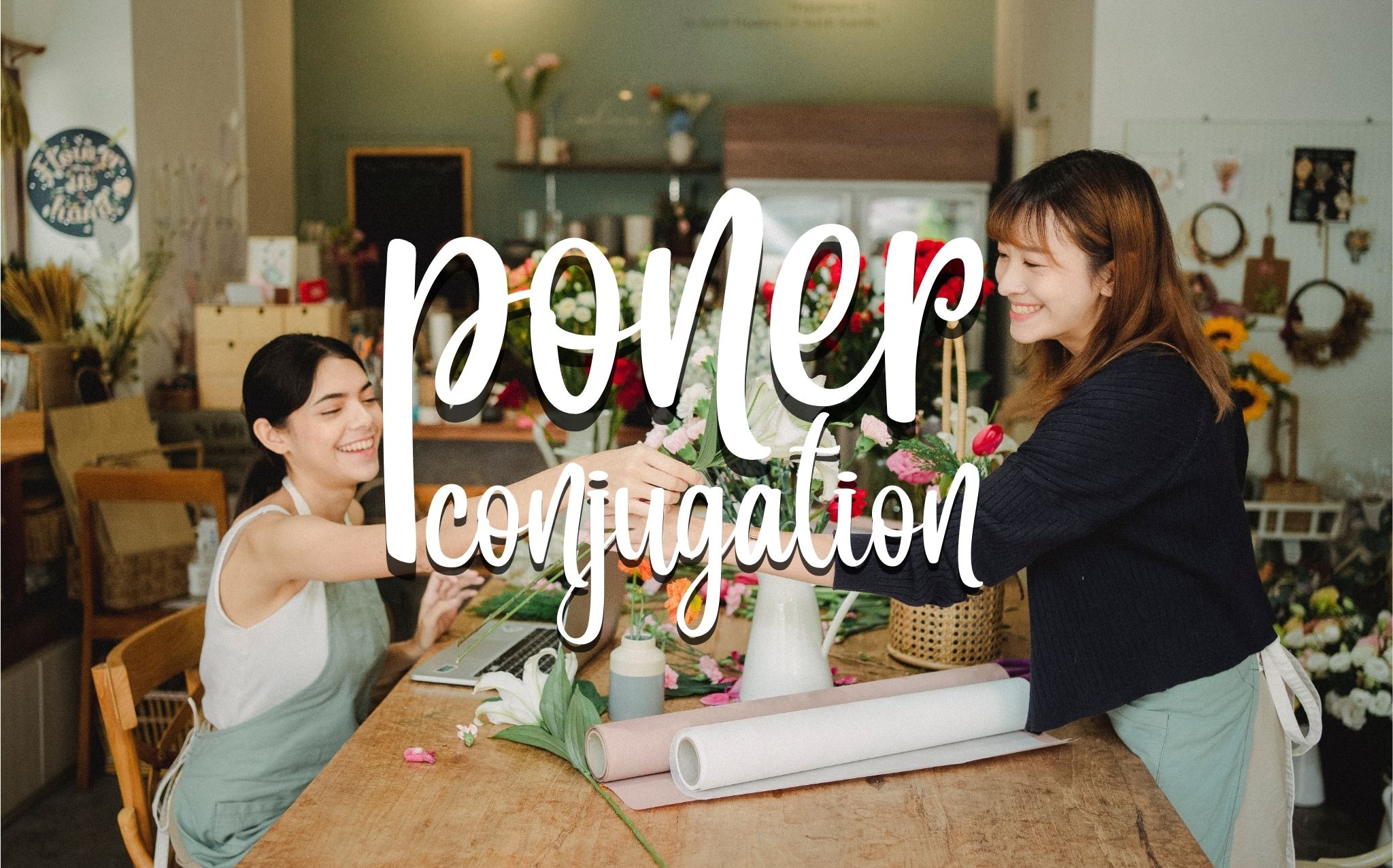Poner conjugation: Every conjugation of Poner in one guide

Get our free email course, Shortcut to Conversational.
Have conversations faster, understand people when they speak fast, and other tested tips to learn faster.
More infoWhen learning a new language, understanding verb conjugation is essential. In Spanish, one verb that you’ll encounter frequently is poner, meaning “to put” or “to place.” As a high-frequency verb, developing a solid grasp of poner conjugation is crucial for effective communication in Spanish.
That’s why in today’s post, we will delve into the depths of poner conjugation, equipping you with a comprehensive guide to master its conjugation patterns across different moods and tenses.
We’ll begin with the uses and meanings of poner, and then go straight into the conjugation of poner in every tense and mood. Keep an eye out for links provided to get more details and information on specific moods and tenses.
Now let’s get started to learn everything about poner conjugation!
Poner meanings
In Spanish, the verb poner has several meanings and uses that can vary widely depending on the context. Here we will cover its four main uses, but we recommend that you check out our dedicated post on the full meanings of poner in English for additional information about how to use this verb in context.
Poner meaning: to put, to place
The most common translation of poner is to put or to place, used to indicate the arrangement or positioning of objects or people.
- No encuentro mis anteojos, estaba segura de que los había puesto en la mesa. – I can’t find my glasses, I was sure I had put them on the table.
- Siempre pongo al bebé en la silla alta para darle de comer. – I always put the baby in the highchair to feed him.
Poner meaning: to set, to set up
Poner in English can also be translated as to set, or sometimes to set up. This use is for setting something into a particular state or condition.
- Pondré la mesa para la cena de aniversario de esta noche. – I’ll set the table for tonight’s anniversary dinner.
- No te escucho, pon el televisor en silencio. – I can’t hear you, set the TV on mute.
Poner meaning: to turn on
Poner can also mean to turn on or to activate something. It is commonly used with electronic devices.
- Pon el aire acondicionado, tengo calor. – Turn on the air conditioning, I’m hot.
- ¿Estamos en una fiesta o no? ¡Pongan la música! – Are we having a party or not? Turn on the music!
Ponerse: to wear, to put on [clothes]
In some contexts, poner is used to express wearing or putting on clothes or accessories. In this case we usually use the reflexive form of ponerse, which takes the poner reflexive conjugation.
- ¿Me pongo el vestido rojo o el azul? – Should I wear the red dress or the blue one?
- Está lloviendo, no te pongas sandalias, Luisa. – It’s raining, don’t wear sandals, Luisa.
Poner conjugation
With our main poner meanings out of the way, now it’s time to go all in on poner conjugation in every Spanish tense!
We’ll break our lesson down by mood to make things easier, and we’ll provide plenty of examples to show each tense in action. Take a look at our big post with all the verb tenses in Spanish for a full overview of each one.
Poner is an irregular verb, meaning that it doesn’t follow the regular conjugation of -er verbs and that many tenses require stem changes. If you’re starting out with Spanish verbs, first take a look at our post on infinitives in Spanish about this basic form, and then you might want to review our post on Spanish stem-changing verbs to learn more about irregular verbs like poner.
Indicative mood
The indicative mood is used to express factual information or make statements. Let’s explore the conjugation of poner in the indicative mood across its different tenses: present, preterite, imperfect, conditional, future, and all the perfect forms.
Poner present conjugation
Poner is a GO verb, which means that the first-person singular yo conjugation ends in -go. The rest of the subjects follow the regular conjugation of -er verbs.
| Subject | Poner conjugation present tense |
| Yo | pongo |
| Tú | pones |
| Él, Ella, Usted | pone |
| Nosotros, Nosotras | ponemos |
| Vosotros, Vosotras | ponéis |
| Ellos, Ellas, Ustedes | ponen |
- Mis tías ponen flores recién cortadas en el florero cada lunes. – My aunts put fresh-cut flowers in the vase every Monday.
- ¿Me pongo este collar o aquel? – Do I wear this necklace or that one?
- Si no le pones empeño, nunca terminarás la universidad. – If you don’t put in the effort, you’ll never finish college.
Head over to our post on the simple present tense to learn more about this essential tense.
Poner conjugation preterite
The stem of poner for the preterite is pus-, followed by the regular endings, except for the first person, which ends in -e.
| Subject | Poner conjugation preterite |
| Yo | puse |
| Tú | pusiste |
| Él, Ella, Usted | puso |
| Nosotros, Nosotras | pusimos |
| Vosotros, Vosotras | pusisteis |
| Ellos, Ellas, Ustedes | pusieron |
- Anoche los vecinos pusieron música a todo volúmen. – Last night the neighbors put on music on full blast.
- Nos pusimos lindas para ir a la fiesta. – We got all dressed up to go to the party.
- Cuando le dije que lo había visto bailar, se puso rojo como un tomate. – When I told him I’d seen him dance, he turned red as a tomato.
For a detailed breakdown of this tense, refer to our post on how to master the Spanish preterite in minutes.
Poner imperfect conjugation
The imperfect poner conjugation follows the regular conjugation pattern of -er verbs, with the stem being pon-.
| Subject | Poner imperfect tense |
| Yo | ponía |
| Tú | ponías |
| Él, Ella, Usted | ponía |
| Nosotros, Nosotras | poníamos |
| Vosotros, Vosotras | poníais |
| Ellos, Ellas, Ustedes | ponían |
- Mi hermana ponía la mesa y yo servía los jugos. – My sister set the table and I served the juices.
- ¿Qué uniforme te ponías para ir a la escuela cuando eras niña, mamá? – What uniform did you wear to school when you were a kid, Mom?
- Cada uno ponía 20 centavos y con eso nos alcanzaba para comer pizzas después de clase todos los viernes. – We each put in 20 cents and that was enough for us to eat pizzas after school every Friday.
As you may know, Spanish has two past tenses, which can sometimes be challenging for learners to grasp. To avoid confusion, we recommend you check our beginner’s guide to the Spanish imperfect tense first and then head over to our anti-confusion guide to preterite vs imperfect tenses.
Poner conditional conjugation
The conditional poner conjugation has a significant stem change: pondr-. The endings follow the regular conditional conjugation pattern.
Poner in the conditional tense is often translated into English as would put.
| Subject | Poner conditional conjugation |
| Yo | pondría |
| Tú | pondrías |
| Él, Ella, Usted | pondría |
| Nosotros, Nosotras | pondríamos |
| Vosotros, Vosotras | pondríais |
| Ellos, Ellas, Ustedes | pondrían |
- Creo que mi hermana se pondría muy mal si supiera que perdí su libro favorito. – I think my sister would get very upset if she knew I lost her favorite book.
- ¿Pondrías esas servilletas en la mesa? – Would you put those napkins on the table?
- Mis perros se pondrían celosos si me vieran jugando con tu cachorro. – My dogs would get jealous if they saw me playing with your puppy.
Enhance your understanding of this tense by checking out our beginner’s guide to the Spanish conditional.
Poner future tense
Poner future conjugation is also irregular, and has the same stem as the conditional, pondr-. Likewise, it still takes the regular future tense endings.
Just like any other verb, the future tense poner conjugation is translated into English by adding the auxiliary will to the English infinitive.
| Subject | Poner future conjugation |
| Yo | pondré |
| Tú | pondrás |
| Él, Ella, Usted | pondrá |
| Nosotros, Nosotras | pondremos |
| Vosotros, Vosotras | pondréis |
| Ellos, Ellas, Ustedes | pondrán |
- Me pregunto qué se pondrá mi hermana para el baile de graduación. – I wonder what my sister will wear to the prom.
- Me pondré muy contento si me gano el bono de puntualidad este mes. – I’ll get really happy if I earn the punctuality bonus this month.
- ¿Dónde pondrás la cama, en el medio o pegada a la pared? – Where will you put the bed, in the middle or against the wall?
Check out our post on future tense Spanish for a full lesson on different ways to express the future in Spanish.
Compound tenses
Now that we’re done with the simple tenses, we present you with the poner conjugation chart for the compound tenses. These are formed by conjugating the auxiliary verb haber and adding the past participle of poner, which is puesto.
For more information about the elements used to form the perfect tenses, take a look at our posts on the Spanish past participle and on the auxiliary verb haber.
For progressive tenses, we use the gerund, which is poniendo.
Let’s begin with the present perfect and past perfect conjugations of poner.
| Subject | Present perfect | Past perfect |
| Yo | he puesto | había puesto |
| Tú | has puesto | habías puesto |
| Él, Ella, Usted | ha puesto | había puesto |
| Nosotros, Nosotras | hemos puesto | habíamos puesto |
| Vosotros, Vosotras | habéis puesto | habíais puesto |
| Ustedes, Ellos, Ellas | han puesto | habían puesto |
- Nosotros hemos puesto mucho dinero para que el proyecto salga bien. – We have invested a lot of money for the project to go well.
- Ellos me dijeron que le habían puesto el seguro a la puerta, pero no fue cierto. – They told me that they had put the lock on the door, but it wasn’t true.
Now, let’s move to the conjugation of poner in the perfect future and perfect conditional.
| Subject | Perfect future | Perfect conditional |
| Yo | habré puesto | habría puesto |
| Tú | habrás puesto | habrías puesto |
| Él, Ella, Usted | habrá puesto | habría puesto |
| Nosotros, Nosotras | habremos puesto | habríamos puesto |
| Vosotros, Vosotras | habréis puesto | habríais puesto |
| Ustedes, Ellos, Ellas | habrán puesto | habrían puesto |
- Para ese entonces ya habré puesto el resto del dinero que debo. – By that time I will have paid the rest of the money I owe.
- Si no me importaras, no te habría puesto atención. – If I didn’t care about you, I wouldn’t have paid attention to you.
For in-depth lessons on each of these tenses, refer to our posts on present perfect Spanish, past perfect Spanish, future perfect Spanish, and the Spanish conditional.
Subjunctive mood
The subjunctive mood is used in Spanish to express doubt, wishes, or uncertainty.
Since the subjunctive mood is used differently in English, you’ll notice in the examples that the translations aren’t always the same. Pay attention to the context rather than trying to look for exact translations. For full explanations of this tricky mood, we also recommend that you take a look at our post on the Spanish subjunctive, simplified.
Now, let’s take a look at our poner subjunctive conjugation in each of these tenses.
Poner present subjunctive
The present subjunctive poner conjugation is formed with the stem of the present indicative conjugation for the first person: pong-, and the regular endings.
| Subject | Poner conjugation present subjunctive |
| Yo | ponga |
| Tú | pongas |
| Él, Ella, Usted | ponga |
| Nosotros, Nosotras | pongamos |
| Vosotros, Vosotras | pongáis |
| Ellos, Ellas, Ustedes | pongan |
- Quiero que pongamos luces de Navidad en la ventana. – I want us to put Christmas lights in the window.
- Puede que pongan otro refrigerador en ese espacio. – They might put another refrigerator in that space.
- No creo que ponga mala cara cuando vea el pastel de cumpleaños que le hice. – I don’t think he’ll put on an angry face when he sees the birthday cake I made him.
Take a deep dive into this tense with our comprehensive post on the present subjunctive tense in Spanish.
Poner imperfect subjunctive
The conjugation of poner in the imperfect subjunctive takes an irregular stem change and turns into pusi-. We include both ways to conjugate poner in this tense.
| Subject | Poner conjugation present subjunctive |
| Yo | pusiera / pusiese |
| Tú | pusieras / pusieses |
| Él, Ella, Usted | pusiera / pusiese |
| Nosotros, Nosotras | pusiéramos / pusiésemos |
| Vosotros, Vosotras | pusierais / pusieseis |
| Ellos, Ellas, Ustedes | pusieran / pusieran |
- Ella me dijo que pusiera música si quería. – She told me that I could put on music if I wanted to.
- Creo que papá no esperaba que nos pusiésemos los vestidos que nos regaló. – I think Dad didn’t expect that we would wear the dresses he gave us.
- Ojalá tus hermanos no te pusieran en esta situación tan difícil. – I wish your brothers wouldn’t put you in this difficult situation.
For an in-depth exploration, don’t miss our post on the Spanish imperfect subjunctive tense.
Poner future subjunctive
The future subjunctive is used rarely in common Spanish and is almost exclusive to literary contexts these days, but we still include it here so that our poner conjugation guide is complete.
| Subject | Poner future subjunctive |
| Yo | pusiere |
| Tú | pusieres |
| Él, Ella, Usted | pusiere |
| Nosotros, Nosotras | pusiéremos |
| Vosotros, Vosotras | pusiereis |
| Ellos, Ellas, Ustedes | pusieren |
- Quienes pusieren mi palabra en entredicho recibirán el rechazo de mi casa. – Those who question my word will be rejected by my house.
- No recibiremos recompensa alguna si no pusiéremos todo nuestro corazón a cumplir con la causa. – We will receive no reward if we do not put our whole heart into the cause.
Compound poner subjunctive conjugation
Perfect forms in the subjunctive are conjugated with the auxiliary verb haber plus the poner past participle: puesto.
The compound subjunctive tenses consist of the perfect subjunctive and the pluperfect subjunctive. The latter requires the auxiliary verb haber to be conjugated in the imperfect subjunctive, and has two correct forms.
| Subject | Perfect subjunctive | Pluperfect subjunctive |
| Yo | haya puesto | hubiera puesto / hubiese puesto |
| Tú | hayas puesto | hubieras puesto / hubieses puesto |
| Él, Ella, Usted | haya puesto | hubiera puesto / hubiese puesto |
| Nosotros, Nosotras | hayamos puesto | hubiéramos puesto / hubiésemos puesto |
| Vosotros, Vosotras | hayáis puesto | hubierais puesto / hubieseis puesto |
| Ellos, Ellas, Ustedes | hayan puesto | hubieran puesto / hubiesen puesto |
- Si hubiesen puesto sus nombres en la lista cuando les dije, ambos podrían ir al taller. – If they had put their names on the list when I told them, they could both go to the workshop.
- Aunque no hayan puesto nada para la fiesta, igual los invitaré porque son mis hermanos. – Even if they didn’t give anything for the party, I will still invite them because they are my brothers.
Imperative mood
The imperative mood in Spanish is used to give commands, instructions, or express requests.
Poner conjugation in the imperative mood looks very similar to its conjugation in the present subjunctive. To understand which mood is being used, pay attention to the situation or context. Note that poner imperative conjugation is different in the negative, so we include both forms here.
| Subject | Poner imperative |
| [Tú] | pon / no pongas |
| [Usted] | ponga / no ponga |
| [Nosotros, Nosotras] | pongamos / no pongamos |
| [Vosotros, Vosotras] | poned / no pongáis |
| [Ustedes] | pongan / no pongan |
- Pon las cosas donde te dije, por favor. – Put the things where I told you, please.
- Hoy es mi cumpleaños, pongan mi canción favorita. – Today is my birthday, play my favorite song.
- ¡No pongas los pies sobre la mesa, hijo! – Don’t put your feet on the table, son!
To learn more about this mood, we explain it all in our post on Spanish commands.
Conclusion
Good job! We’ve seen every poner conjugation with plenty of examples to demonstrate each one. How about a quick review to wrap things up?
We began by exploring the main uses of poner, from indicating placement and setting to turning on or wearing something.
Then we dove right into the conjugation of poner, learning that it’s an irregular verb that changes stem in many tenses. In addition, we saw that poner is a GO verb, which means that it takes a -go ending for the first-person singular in the present indicative. Through the rest of the post, we covered each and every poner conjugation in the indicative, subjunctive, and imperative mood.
With this comprehensive poner conjugation guide at your disposal, you now have a reliable reference to consult whenever you need to conjugate poner in any tense or mood!
Poner conjugation exercises
Ready to put your conjugation skills to the test? Why not try out this set of exercises to see how well you master your poner conjugation?
Give it your best shot, and let’s see how well you can handle these conjugations according to the mood and tense in parentheses. The answers and translations are provided below.
1. ¿Por qué no _____ el cuadro que les regalé en la pared? (indicative: present perfect)
2. No _____ la ropa blanca y de color en el mismo cesto, chicos. (imperative)
3. ¿Te _____ la camisa roja o la azul? (indicative: future)
4. ¿Dónde quieres que _____ estas cajas? (subjunctive: present)
5. Ya te dijimos que no _____ tus libros en el suelo. (indicative: preterite)
6. Recuerdo que usted siempre _____ su bastón junto a los paraguas. (indicative: imperfect)
7. Si mi esposo no _____ nada en la mesa, estoy segura de que no se habría quebrado. (subjunctive: pluperfect)
8. No te preocupes, yo _____ la mesa. (indicative: future)
9. Quizá si _____ de su parte, no tendrían tantos problemas en la escuela. (subjunctive: imperfect)
10. Si esa falda fuera de mi talla, me la _____ para ir al evento. (indicative: conditional)
Answers
1. ¿Por qué no han puesto el cuadro que les regalé en la pared? – Why haven’t you put the picture I gave you on the wall?
2. No pongan la ropa blanca y de color en el mismo cesto, chicos. – Don’t put the white and dark clothes in the same basket, boys.
3. ¿Te pondrás la camisa roja o la azul? – Will you wear the red shirt or the blue shirt?
4. ¿Dónde quieres que ponga estas cajas? – Where do you want me to put these boxes?
5. Ya te dijimos que no pusimos tus libros en el suelo. – We already told you we didn’t put your books on the floor.
6. Recuerdo que usted siempre ponía su bastón junto a los paraguas. – I remember you always put your cane next to the umbrellas.
7. Si mi esposo no hubiera puesto nada en la mesa, estoy segura de que no se habría quebrado. – If my husband hadn’t put anything on the table, I’m sure it wouldn’t have broken.
8. No te preocupes, yo pondré la mesa. – Don’t worry, I’ll set the table.
9. Quizá si pusieran de su parte, no tendrían tantos problemas en la escuela. – Maybe if they did their part, they wouldn’t have so many problems at school.
10. Si esa falda fuera de mi talla, me la pondría para ir al evento. – If that skirt were my size, I would wear it to the event.



